Stranger Than Fiction
December 2022
Real-Life Mysteries
By Dean Jobb
A vanishing judge. Murdered hikers. A motion-pictures pioneer who disappeared. The tipster who led the Nazis to Anne Frank’s Amsterdam hideaway. And the cover-up that allowed a Gilded Age poisoner to get away with murder. A roundup of recent books that reopen unsolved crimes spanning more than a century and offer startling, long-overdue solutions.
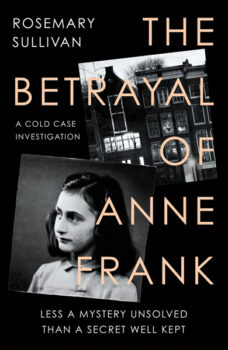 Canadian author Rosemary Sullivan calls it “the coldest of cold cases.” Almost eighty years ago, in the summer of 1944, someone betrayed the family of Jewish teenager Anne Frank during the Nazi occupation of Holland, revealing their hiding place above an Amsterdam warehouse. The family was deported to Germany and she died of typhus in the notorious Bergen-Belsen concentration camp in February 1945.
Canadian author Rosemary Sullivan calls it “the coldest of cold cases.” Almost eighty years ago, in the summer of 1944, someone betrayed the family of Jewish teenager Anne Frank during the Nazi occupation of Holland, revealing their hiding place above an Amsterdam warehouse. The family was deported to Germany and she died of typhus in the notorious Bergen-Belsen concentration camp in February 1945.
Millions of people have read Frank’s diary, which was published after the Second World War and has made her of one the most famous victims of the Holocaust. But the identity of the tipster whose actions signed her death warrant has remained a mystery. In The Betrayal of Anne Frank: A Cold Case Investigation (Harper), Sullivan chronicles a five-year, high-tech investigation launched to expose the person responsible.
A retired FBI agent, Vincent Pankoke, and a team of investigators pored over tens of thousands of pages of documents, created a database to cross-reference and manage the deluge of information, and interviewed scores of descendants of people with connections to the Franks and their capture. Sullivan, who has written fifteen books and is best known for her 2015 biography Stalin’s Daughter, presents their findings as she recreates the Franks’ ordeal—the family was in hiding for more than two years—and the dangerous, traitor-filled world of occupied Holland, where bounties were offered to those who betrayed Jews.
The book reads less like a whodunit and more like a who-didn’t-do-it as the team identifies and rejects a list of possible suspects before zeroing in on the likely culprit, a prominent Dutch Jew. The book’s conclusions have been controversial, especially in Holland, where Sullivan’s publisher—bowing to pressure from historians who dispute the team’s findings—withdrew the Dutch-language edition. The effort to denigrate this even-handed, carefully researched book is reason enough to check it out and reach your own conclusions about whether the case has been solved.
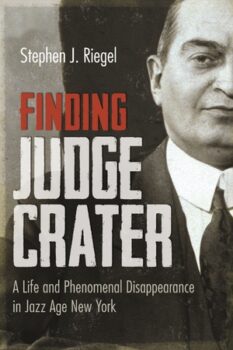 Before Amelia Earhart and Jimmy Hoffa, the most famous missing person in the world was Judge Joseph Crater. A prominent Manhattan attorney and Democratic Party organizer, “Good Time Joe,” as he became known, was a big spender who frequented Broadway’s restaurants and speakeasies with a succession of chorus girls and without his wife. And on a summer night in 1930, four months after he was appointed to the New York Supreme Court, he hopped into a taxicab on West Forty-Fifth Street and was never seen again.
Before Amelia Earhart and Jimmy Hoffa, the most famous missing person in the world was Judge Joseph Crater. A prominent Manhattan attorney and Democratic Party organizer, “Good Time Joe,” as he became known, was a big spender who frequented Broadway’s restaurants and speakeasies with a succession of chorus girls and without his wife. And on a summer night in 1930, four months after he was appointed to the New York Supreme Court, he hopped into a taxicab on West Forty-Fifth Street and was never seen again.
In Finding Judge Crater: A Life and Phenomenal Disappearance in Jazz Age New York (Syracuse University Press), New York lawyer and former federal prosecutor Stephen J. Riegel sets out to unearth what happened to the judge and who was responsible for his vanishing act. “Crater’s disappearance would spawn arguably the greatest manhunt for a missing person in the nation’s history up to that time,” he writes, “unprecedented in its cost, length, and scope.” There were plenty of theories, ranging from kidnapping and murder to an untimely death in a brothel. Or perhaps he had staged his final night on the town as his swan song, before he dropped out of sight and escaped to a new life.
Riegel immerses readers in the riotous nightlife of 1920s Manhattan, where the elite rubbed shoulders with the underworld in a mutual pursuit of Prohibition-restricted booze. When he was not enjoying this nocturnal playground, Crater was making his name as a Tammany Hall foot soldier, and the author plumbs the corrupt depths of the city’s notorious political machine. Governor Franklin Roosevelt had just rewarded the forty-one-year-old with a coveted judicial appointment when he disappeared.
The New York police made inquiries as far away as North Dakota, Nova Scotia, and Cuba, and a grand jury grilled almost a hundred witnesses. But Riegel suspects the Tammany-controlled investigation was window-dressing; powerful people, he discovered, had good reason to want Crater out of the way and even better reasons to ensure he was never found. Finding Judge Crater presents a compelling and plausible solution to this enduring mystery.
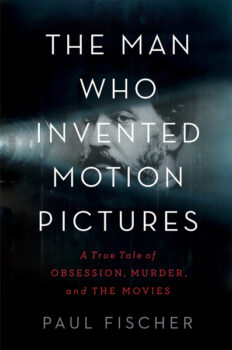 Forty years before Crater jumped into a cab and disappeared, an inventor named Louis Le Prince boarded a Paris-bound train at a station in Dijon, France and was never seen again. Like Crater, he vanished just as his career was about to move to the next level. Le Prince was on his way to England, where he had developed a device to capture what he called “moving photographs”—the world’s first motion-picture camera. His next stop would have been New York, where he planned to unveil the breakthrough invention.
Forty years before Crater jumped into a cab and disappeared, an inventor named Louis Le Prince boarded a Paris-bound train at a station in Dijon, France and was never seen again. Like Crater, he vanished just as his career was about to move to the next level. Le Prince was on his way to England, where he had developed a device to capture what he called “moving photographs”—the world’s first motion-picture camera. His next stop would have been New York, where he planned to unveil the breakthrough invention.
Author, screenwriter, and film producer Paul Fischer dives into the mystery surrounding Le Prince’s 1890 disappearance in The Man Who Invented Motion Pictures: A True Tale of Obsession, Murder, and the Movies (Simon & Schuster), a tour de force of historical detective work. Le Prince, he writes, was a genius “who foresaw the world to come”—a world where images of the present could be recorded for the future—“but did not live to see it materialize.”
Fischer tackles this 132-year-old mystery with meticulous research and vivid storytelling. Did Le Prince’s precarious finances drive him to suicide? Or was he murdered—“eliminated,” as his son Adolphe put it—to prevent him from demonstrating his camera? An unlikely suspect emerged when Thomas Edison, creator of the electric light bulb and the photograph, introduced a moving-picture camera called the Kinetograph less than a year after the disappearance. Like the television detectives who swear there’s no such thing as a coincidence, Le Prince’s family was convinced the famous American inventor was somehow responsible.
“There is romance in the story of an underdog inventor disappearing, as if by magic, from a Victorian train,” Fischer notes, “as there is romance in the sensational theory that Thomas Edison . . . had him assassinated.” The truth, however, should have been obvious all along, the author asserts, and he produces a suspect who had opportunity, motive, and claimed to be one of the last people to see Le Prince alive. The story of the birth of the movies, it turns out, may finally have a tidy Hollywood ending.
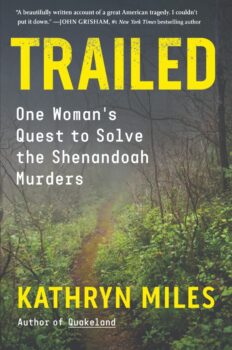 Almost a century after Le Prince disappeared, in the spring of 1996, backpackers Lollie Winans and Julie Williams went missing while on a trek though Virginia’s Shenandoah National Park. Their bodies were found at a secluded campsite, and while a suspect was linked to their brutal murders, no one was charged. The case had long faded from the headlines when Maine-based author, journalist, and writing instructor Kathryn Miles, an experienced backcountry hiker, pitched a feature on the murders to Outside magazine in 2016. The assignment turned into a personal mission to find the killer.
Almost a century after Le Prince disappeared, in the spring of 1996, backpackers Lollie Winans and Julie Williams went missing while on a trek though Virginia’s Shenandoah National Park. Their bodies were found at a secluded campsite, and while a suspect was linked to their brutal murders, no one was charged. The case had long faded from the headlines when Maine-based author, journalist, and writing instructor Kathryn Miles, an experienced backcountry hiker, pitched a feature on the murders to Outside magazine in 2016. The assignment turned into a personal mission to find the killer.
In Trailed: One Woman’s Quest to Solve the Shenandoah Murders (Algonquin Books), Miles invites readers to join her as she reopens the case, interviews those closest to Winans and Williams, and reassesses the original investigation. While she confesses a “voyeuristic fascination” with true crime, “the reality of criminal investigation”—inspecting a murder scene and viewing autopsy photos and other evidence of violent death—“leaves an indelible mark on those who are willing to look.” She also wrestled with the “deep wounds” her inquiries were bound to reopen for the young couple’s relatives and friends.
Miles uncovered a bigger and far more troubling story. Murders and violent assaults are shockingly common in American state and national parks, as killers take advantage of remote locations to stalk and attack their prey, most of them women. Parks officials, she discovered, often downplay the risks and few administrators collect statistics on the number of crimes committed within park borders. Park rangers were only beginning to take on a law enforcement role in the 1990s and were ill-prepared to investigate the Shenandoah double murder alongside the FBI. And crime scenes exposed to the elements can make evidence-gathering a challenge, if not impossible. As one federal agent who explained the protocols for collecting forensic evidence told Miles: “Good luck doing any of that out in the woods.”
Trailed is gripping, immersive, first-rate true crime—engagingly told, respectful in tone, damning in its conclusions. Miles digs deep into investigative records to document the wrong turns and flawed assumptions that produced a dubious suspect and ignored evidence that linked a serial murderer and rapist to the crime scene. When the best-selling author of legal thrillers John Grisham provides a cover blurb that says “I couldn’t put it down,” how can true crime fans resist?
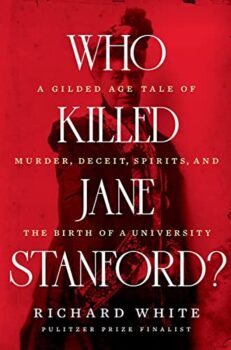 Jane Stanford was supreme ruler of the university near San Francisco that bore her family’s name. The institution had been founded in 1885 as a monument to her son, who died just short of his sixteenth birthday. It was financed from the fortune amassed by her late husband, Leland Stanford, a former California governor and senator, as president of the Southern Pacific Railroad. When a professor suggested, correctly, that many Gilded Age railroad moguls were crooks, she demanded he be fired. When the university’s president refused to bow to her will on other issues, she plotted to replace him. Stanford, noted the head of Harvard University, operated at the whim of “one aged woman.”
Jane Stanford was supreme ruler of the university near San Francisco that bore her family’s name. The institution had been founded in 1885 as a monument to her son, who died just short of his sixteenth birthday. It was financed from the fortune amassed by her late husband, Leland Stanford, a former California governor and senator, as president of the Southern Pacific Railroad. When a professor suggested, correctly, that many Gilded Age railroad moguls were crooks, she demanded he be fired. When the university’s president refused to bow to her will on other issues, she plotted to replace him. Stanford, noted the head of Harvard University, operated at the whim of “one aged woman.”
The reign of the university’s “golden goddess,” as one newspaper columnist called her, came to an abrupt end in 1905, during a stopover in Hawaii as she travelled to Japan. Someone added strychnine to an antacid and she died soon after taking it. A coroner’s jury ruled she had been murdered but, as Richard White shows in Who Killed Jane Stanford?: A Gilded-Age Tale of Murder, Deceit, Spirits and the Birth of a University (W.W. Norton), there was a concerted effort to cover up the crime. San Francisco’s police, the city’s newspapers, and university officials ignored the evidence and insisted the seventy-six year-old had died of natural causes.
White, a retired Stanford history professor, is the perfect guide to sorting out the feuds, competing agendas, and byzantine plots at play, not only at the university but within the corruption-filled political and business circles of San Francisco at the dawn of the twentieth century. His biggest obstacle, he admits, was extracting the truth hidden behind a Churchillian bodyguard of lies. He relished the challenge. “If people did not lie,” he notes, “historians and detectives would not have work, at least not interesting work.” He explodes the lies, rejects the false leads, and juggles a bloated cast of characters without losing track of the whodunit at the heart of the story.
White enlisted the help of his brother, who writes crime novels, to review the evidence and makes a convincing case for who killed Stanford and why, how the crime was carried out, and who colluded to hide the truth. In our own time of “surreal conspiracy theories,” he notes, Stanford’s death “is a reminder that conspiracies can be quite real.”
———
Dean Jobb’s latest book, The Case of the Murderous Dr. Cream: The Hunt for a Victorian Era Serial Killer (Algonquin Books), won the inaugural CrimeCon Clue Award for True Crime Book of the Year and was longlisted for the American Library Association’s 2022 Andrew Carnegie Medal for Excellence. He teaches in the MFA in Creative Nonfiction program at the University of King’s College in Halifax, Nova Scotia. Find him at www.deanjobb.com
